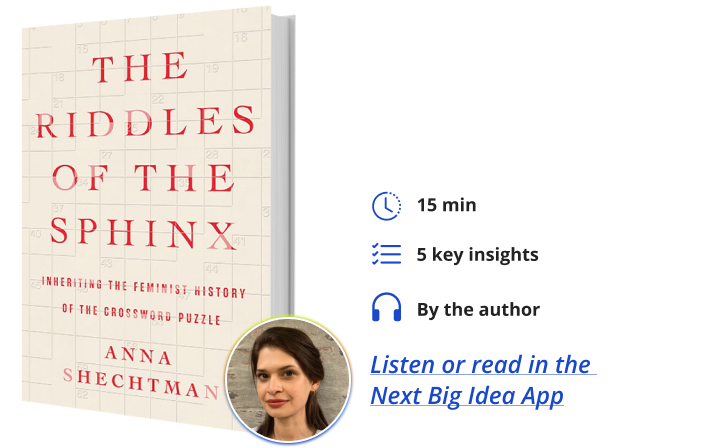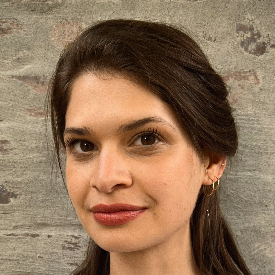Anna Shechtman is an author and crossword constructor for the New Yorker and The New York Times. She has a PhD in English literature and film and media studies from Yale University. A Klarman Fellow at Cornell University, she will be an assistant professor in the Department of Literatures in English in 2024.
Below, Anna shares five key insights from her new book, The Riddles of the Sphinx: Inheriting the Feminist History of the Crossword Puzzle. Listen to the audio version—read by Anna herself—in the Next Big Idea App.

1. The history of the crossword puzzle surprisingly intersects with the history of feminism.
Between 1913, when the crossword puzzle was invented, and the 1960s, most crosswords were created by women. These women were often bored housewives with college degrees that they otherwise weren’t putting to use. They wanted careers but, before the second wave, not the social stigma of being “career women.” Now, more than 80 percent of crosswords are created by men.
There are at least three causes of this “masculinization” of the industry. First, it’s partly a function of a changing workforce. As more women entered the labor market and were still expected to do the large share of housework and childcare, few had time for this rarified, low-wage puzzle work. It’s also informed by the impacts of computing on crossword construction and the invention of the “nerd” stereotype—both of which have reshaped the demographics of the “CrossWorld” (as we sometimes call it) in the image of Silicon Valley.
My first experience of the gender gap in the world of puzzle-making came after I published two crosswords in the New York Times at age 19. I began to be known among other constructors and puzzle editors not just as a puzzle maker but as a woman puzzle maker. I was solicited to create puzzles by male editors looking to diversity their bylines, and in 2014, Will Shortz, the long-term editor of the New York Times crossword, asked me to be his assistant. It was an incredible opportunity, but one that also sensitized me to the politics of the puzzle.
My gender difference informed my sense of what were good and bad puzzles, what words were worth including in the page’s grid, and what weren’t. Shortz edits up to 95 percent of the clues in a daily Times puzzle, so we spent most of our days free-associating together in his home office. Our worldviews were markedly different. He, in his sixties, is from rural Indiana. I, then 23, am from lower Manhattan. But one of the largest sources of static in our communication was gender. Is the term “male gaze,” for example, puzzle-worthy? Could he expect solvers to know it? Of course I thought it would be and that he could. He disagreed.
2. Because they patrol the borders of “common knowledge” and “proper usage,” crosswords have become hot zones in today’s culture wars.
What words and phrases are “puzzle-worthy” is ultimately a fraught question: are crosswords in mainstream newspapers too white? Too straight? Too male? Can words, stripped of syntax, carry all this baggage? Will diversifying the demographics of crossword constructors necessarily diversify the words included in the puzzles themselves? The history of the crossword puzzle offers a dramatically clear view of the politics of language—how and why words become such political objects, drawing communities together and fracturing them with equal force.
I’ve compiled a list of words from peers of mine—fellow cruciverbalists—that have been rejected by white, male editors at wide-circulation newspapers for being “too niche” or “not relevant enough” for the editors’ imagined audience of solvers. This list includes bell hooks, matcha tea, Riotgirl, Laverne Cox, and Marie Condo.
“The history of the crossword puzzle offers a dramatically clear view of the politics of language.”
A pattern develops when looking at these entries: they have their origins in women-produced and non-white cultures. By trying to institute a policy of inclusion—looking to address the largest audience without including so-called niche words in their grids—many editors have established a tacit policy of exclusion. In the past five or so years, many efforts have been made to redress these exclusions—including diversifying editorial staff at newspapers’ puzzle sections and new initiatives meant to mentor constructors from underrepresented communities. Those of us committed to these diversifying efforts are often left to wonder: are we taking ourselves and the puzzles way too seriously? Why politicize a pastime? And yet, the puzzle is an intensified microcosm for questions about common usage and its politics that plague all forms of representation.
3. The 1920s witnessed a “crossword craze” in the United States.
Dictionaries were reportedly placed next to bibles in hotel rooms; baseball managers worried that the grid would replace the diamond as America’s favorite pastime. In cartoons, novelty songs, and even on Broadway, the New Woman of the 1920s became an unexpected emblem of the “crossword craze.” Her desires to date, to work, and to vote were just as inscrutable to patriarchy as the 15-by-15 grid.
The dangerous fantasy of the puzzle woman is perhaps most famously registered in the 1925 novelty song “Crossword Mama.” A “puzzling woman,” she devotes herself to the crossword as a proxy for other fashions of the time. Like the flapper, she is liberated from the corsets and the customs of the Victorian age. A double-crosser, she is not to be trusted: The song’s lyrics start: “You call me ‘honey’—that means ‘bee’! / Looks like I’ll be stung no doubt.” The conceit extends across nine verses: “I heard you mention ‘butcher’—that means ‘meat’! / Who you gonna ‘meet’ tonight?” But, like the Sphinx before her, the Crossword Mama solicits a solution: “Crossword Mama, you puzzle me,” the chorus concludes. “But Papa’s gonna figure you out.”
There are hundreds of other Jazz Age relics that conflate the flapper and the crossword as icons of the Zeitgeist. In these images, the puzzle represents the enigma of female desire and fuels the intimacy between men and women in an otherwise chaste culture of heterosexual courtship. It allows verbal and physical taboos to be breached, as members of the opposite sex say four-letter words to each other, cuddling around the newspaper page. “You naughty boy—it couldn’t be that word!” reads the caption on a postcard featuring two young solvers, a blushing man and a woman clutching her breast. By the dual logic of the crossword craze, the woman is the puzzle, and the puzzle brings solvers closer to their desire. The puzzle, in other words, is a sex object.
4. Historically, crosswords have been created with graph paper and pencil.
Since the 1990s, constructors have increasingly used software to create their grids. The processes couldn’t be more different. Instead of working to cross words in her notebook, a digital constructor is constantly updating her “word list”—a database of words, ranked according to how “puzzle-worthy” they are, which feeds an algorithm that populates the grid on its own. The constructor still intervenes in meaningful ways (most importantly, she still writes the clues), but the puzzle’s grid is no longer a plotted “space” that she enters so much as an ongoing activity. Instead of focusing only on words as material clumps of letters divorced from their meanings, she thinks almost exclusively about meanings, constantly reminding her of her most embodied interactions: how a word or phrase makes her feel, where she was when she first encountered it, the contexts and communities in which she uses it.
“Many contemporary constructors come from STEM fields and are interested in crossword construction as a natural language processing problem.”
The development and rise of constructing software have meaningfully changed the kind of work the puzzle maker does and also the kind of person who does it. Many contemporary constructors come from STEM fields and are interested in crossword construction as a natural language processing problem: can a computer make a better crossword than a person can? Like so many industries before it, though—including the history of computer programming itself—the work that a computer “can” do as well or better than a person neatly overlaps with the kind of work women have been encouraged to do. Just as women were the earliest computer programmers, edged out of that work once the computer itself could perform its work encoding and debugging, there is reason to believe that women have been edged out of crossword constructing now that the computer does the “weaving with language” that has historically been coded as women’s work.
5. The women who populate this feminist history of the crossword puzzle shared a desire to work in a culture that was not properly their own.
Many of them found the terms “woman” and “worker” (or “woman” and “writer”) simply incompatible. They sought ways to accommodate their ambition and their appetites—for a career, for power, for knowledge—within the limiting terms of femininity. They developed punishing relationships to their own body and the body of language, trying to discipline both into a relation that would spell success for them in the rigid terms of their social worlds. Sometimes they developed eating disorders, alcoholism, and other coping mechanisms that isolated them from other workers and other women.
It’s not a stretch to imagine the crossword puzzles that occupied them as yet another coping mechanism for life under patriarchy. The first editor of the New York Times crossword puzzle, Margaret Farrar, never identified her work as a “job.” It was something she did to occupy her mind, in addition to her work as a mother of three and the wife of publisher John C. Farrar, co-founder of Farrar, Strauss, and Giroux. Before she met John, she was the editor of the Simon & Schuster puzzle books, which were the first books—all best-sellers—that S&S produced. She invested the money she earned with these books and used it to finance FSG in its earliest years.
In brief, even though Margaret Farrar didn’t identify as a career woman or culture worker, there would be no New York Times puzzle, no Simon & Schuster, and no FSG without her crosswords.
Margaret is just one of the women in the history of crosswords. Others are suffragists, lesbian separatists, Lacanian psychoanalysts, and one-self-taught James Joyce scholar. All of these women shaped the feminist history crossword puzzle and reveal its thorny but rich relationship to the politics of language.
To listen to the audio version read by author Anna Shechtman, download the Next Big Idea App today:































